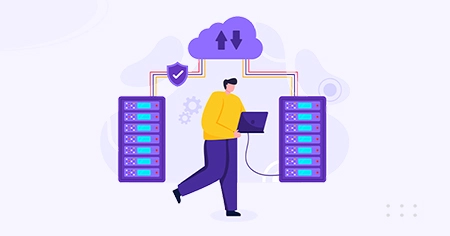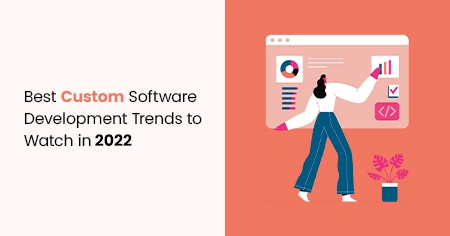Though the software development industry was better prepared than other industries when the pandemic struck, it could not avoid spending cuts, project delays, and staffing reductions. The Information Technology (IT) sector will recover: it returned to a growth trend line in 2022 and is expected to regain and surpass its pre-pandemic position by 2024, with a 5% CAGR.
This article examines the most important custom software development trends that will shape the IT industry in 2022 and how they might affect your business.
Whether you intend to build custom software or have a custom-built product that requires scaling, here are the custom software development trends to keep an eye on.
1. Cloud Technology

When the pandemic struck two years ago, many businesses were forced to close, making on-site data access difficult. Softcircles relies on cloud solutions such as AWS, Azure, and Google to keep data flowing smoothly. Cloud computing became ideal for those who chose to work from home.
Because the pandemic shows no signs of abating this year, developers of cloud-native applications will most likely continue to focus on companies that still use remote work setups.
2. Blockchain

Blockchain technology is most commonly associated with cryptocurrencies such as bitcoin, but it has also found other applications in business today. A decentralized, secure database can be used as a ledger for transactions and other documents. As more blocks are created, authorized parties add them to the catalog for viewing. These records are irreversible and thus permanent, increasing organizational transparency. It would be easier to locate records without having to worry about discrepancies.
3. Low-code and No-code Development Tools
We are experiencing a tech talent shortage due to the ongoing pandemic and rapid technological advancements. As a result, some businesses no longer have the time or human resources to create applications from scratch. This is where low-code and no-code tools come into play. Because these platforms require little or no coding, workers with no coding knowledge will be able to create programs and websites. If the organization has a development team, its members can focus on tasks that require actual coding.
4. Changes in container development
Docker has long been one of the most popular container solutions, with Mesos, Swarm, and Kubernetes as competitors. The latter has now won the presidency. Kubernetes grew a devoted following and established itself as a global authority on container development. Kubecon + CloudNativeCon drew 12 000 attendees, doubling the company's attendance rate from the previous year.
Kubernetes will become the industry standard for container development, with more developers abandoning Docker as their preferred solution.
5. The monopoly of AWS faces challenges.
Amazon Web Services was the first global public cloud infrastructure to allow businesses to move computing operations to remote servers. However, AWS is unlikely to be the most popular despite being the first. According to Canalys, AWS controls 32.6 percent of the market, while Azure and GCP control the remaining 22.4 percent. Microsoft has challenged Amazon with its Azure infrastructure and the JEDI Cloud project, which will collaborate with the Pentagon. Google is not far behind, either: the company has invested in cloud-native computing for business owners and government agencies. IBM acquired Red Hat, one of the market's most promising cloud service providers.
6. Software Integration
Standalone applications are no longer adequate for an organization's operational needs. Spreadsheets, graphics, and text files, for example, may be required from another program to create a report or presentation.
The company can provide a seamless user experience by incorporating integration features into its custom software. For example, they can easily import files or embed outputs from other programs without converting formats, avoiding conflicts. This helps the company save time and increase productivity by reducing troubleshooting problems.
Custom Web Design Services
At SoftCircles, We provide custom software solutions that solve real-world business challenges and high-visibility BI reporting to help you do better business today. When you work with clients worldwide to create custom programs, staying updated on the latest custom software development trends is part of the job description. We do not favor one technology or brand over another. Instead, we concentrate on providing you with the specific solutions your business requires to remain competitive.
7. Global recognition of micro services
Recent advances in cloud and container development are encouraging more developers to consider microservices as a leading form of architecture. Monolith architecture (in which you build one large service and add new features to it as the project grows) has long been proven unsalable. Nonetheless, because of so many advancements in Cloud computing, microservices may only be able to peak now.
Rather than creating a single excellent service, developers will divide the functionality into manageable sections. The software will consist of microservices, each performing a single function flawlessly. Make a change in one microservice if you need to update a process.

8. Artificial intelligence x Chatbots
Artificial intelligence receives much media attention, and you have probably seen or heard various reports on the subject. When you are labeled on someone's Facebook photo or receive personalized recommendations on Netflix or Spotify, it means "a touch of AI" was used to get it done. Deep Blue used artificial intelligence to defeat Garry Kasparov, a chess grandmaster and possibly the best player in the infamous Deep Blue versus Garry Kasparov chess match of 1997. However, how could AI assist your organization? Let us get serious now.
With each passing day, computer-based intelligence becomes more brilliant, and this growing ability makes collaborating with chatbots a wonderful, engaging experience for clients and clients. Chatbots powered by artificial intelligence also helps businesses by gathering information and connecting with customers.
9. 5G network

The 5G network has been in the works for quite some time, but communications experts are confident that it will be released this year and become one of the leading IT trends in 2022. For developers, this means that connectivity will improve significantly, and users will be able to receive online offers from all over the world. It also implies faster mobile connection speeds for incorporating complex innovations such as machine learning or augmented reality into mobile apps.
5G will open up new opportunities for mobile gaming while also making communications much faster and more accessible. Developers can try out new applications and incorporate cutting-edge technologies into mainstream solutions.
10. The rise of Python
Python is a programming language that meets all of today's development requirements. This language can handle web development, mobile development, and enterprise projects. Python's ability to perform complex mathematical operations, data analysis, machine learning, and neural network construction distinguishes it from other universal languages.
As you can see, the language has already surpassed Java and C in popularity. Its growth rate is astounding: the language's demand has increased twofold.
11. Outsourcing development
Outsourcing software development gives business owners more flexibility and lowers costs. Managers do not need to hire new in-house developers and pay them regularly if their teams lack skills in specific tech stacks; instead, they can collaborate with a remote provider and pay the team on an hourly or per-project basis.
Growing software development markets in Eastern Europe, particularly Ukraine, pose a significant challenge to Western colleagues. Developers have the same, if not higher, level of expertise but much lower rates due to price differences between local and American prices. Their understanding of potential solutions is much broader because they work with multiple industries and stacks.
12. The rise of new languages
Java, and Python, new languages have their place. The last decade has surprised us with many elegant languages, including Go, Swift, Rust, and TypeScript. These tools are easier to learn and master, the syntax is more explicit, and the projects are easier to maintain.
New languages, such as PHP, founded in 1994, are adapted to new hardware and meet high user expectations. They prioritize fast performance, multi-threaded processing, cross-device optimization, and seamless deployment. Importantly, these new languages are supported by large corporations (Go by Google, Swift by Apple, and Rust by Microsoft), which have been heavily investing in the growth of these projects in recent years.
13. Progressive Web Apps (PWAs)
With the rise of mobile and web applications in recent years, businesses compete for brand visibility by providing a streamlined digital experience to online customers. However, because the web and mobile programming are so dissimilar, quickly deploying and maintaining different versions of the same software has become increasingly impractical and costly. Fortunately, PWAs have been developed to address this issue.
PWAs are a hybrid of web and mobile applications built with web-based languages such as CSS, HTML, and JavaScript. In other words, they retain web-based programming's high responsiveness, flexibility, and portability while displaying the look and feel of a native app. While PWAs are popular among cash-strapped startups due to their versatility, many well-known brands, including Twitter, Walmart, Starbucks, and Instagram, are also using them.
Unsurprisingly, the global market for PWAs is expected to grow at a 31.9 percent CAGR, reaching $10.44 billion by 2027.

14. The growth and rise of DevSecOps
For many years, DevOps has been revolutionizing software development methods. The combined approach to development and testing brings teams together for a common goal and allows for the developing of higher-quality products. By sharing responsibility, developers and testers can begin developing the product according to best practices, eliminating the need to rebuild functionality.
However, one piece of the puzzle was frequently missing in the traditional DevOps system. The final solution was vulnerable to cyber threats because testing did not always cover necessary security practices. DevSecOps is a development model that addresses this issue by placing a deposit at the center of the development project.
DevSecOps is a new approach to incorporating security practices into the development process. Security teams do not work at the end of a project but rather from the beginning, assisting developers and testers in optimizing the safety of their operations.
15. New trends in technology for self-taught programmers
The demand for software developers is constantly increasing, particularly for skills such as Python development and Node.js development. On the other hand, colleges cannot keep up with ever-changing technological trends and offer outdated courses unrelated to the interests of employers.
Online learning platforms such as Udemy and Coursera provide new developers with fresh perspectives on their chosen field and programming tools without paying for expensive college tuition. Business owners and technology companies must understand this trend and be prepared to welcome professionals with no formal education.
Conclusion
Businesses are increasingly turning to custom software development. In addition, we all know why. It provides tailored solutions, flexibility and freedom to scale, smoothest integration, and much more.
In this article, we discussed the various trends that will shape the custom software development industry in 2022. So, if you plan to use this approach to build internal or customer-facing software, keep up with the trends.








